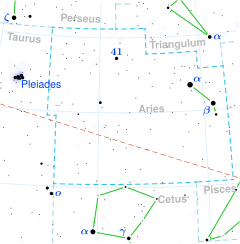Beta Arietis
| Observation data Epoch J2000 Equinox J2000 | ||
|---|---|---|
| Constellation | Aries | |
| Right ascension | 01h 54m 38.41099s[1] | |
| Declination | +20° 48′ 28.9133″[1] | |
| Apparent magnitude (V) | 2.655[2] | |
| Characteristics | ||
| Spectral type | A5 V[3] | |
| U−B color index | +0.170[2] | |
| B−V color index | +0.142[2] | |
| Absolute magnitude (MV) | 1.55 ± 0.09[5] | |
Argument of periastron (ω)(secondary) | 209.1 ± 1.2° | |
| Details | ||
| A | ||
Gyr | ||
| B | ||
| Mass | 1.34 ± 0.07[6] M☉ | |
| Luminosity | 1.3[6] L☉ | |
HIP 8903.[12] | ||
| Database references | ||
| SIMBAD | data | |
| ARICNS | data | |
Beta Arietis (β Arietis, abbreviated Beta Ari, β Ari), officially named Sheratan /ˈʃɛrətæn/,[13][14] is a star system and the second-brightest star in the constellation of Aries, marking the ram's second horn.
Nomenclature
Beta Arietis is the star's Bayer designation. It also bears the Flamsteed designation 6 Arietis.
The traditional name, Sheratan (or Sharatan, Sheratim),[11] in full Al Sharatan, is from the Arabic الشرطان aš-šaraţān "the two signs", a reference to the star having marked the northern vernal equinox together with Gamma Arietis several thousand years ago. [citation needed] In 2016, the International Astronomical Union organized a Working Group on Star Names (WGSN)[15] to catalogue and standardize proper names for stars. The WGSN approved the name Sheratan for this star on 21 August 2016 and it is now so entered in the IAU Catalog of Star Names.[14]
In
Properties
Beta Arietis has an apparent visual magnitude of 2.66. Based on parallax measurements, it is located at a distance of 59.6 light-years (18.3 parsecs) from Earth. This is a spectroscopic binary star system consisting of a pair of stars orbiting around each other with a separation that can not currently be resolved with a conventional telescope. However, the pair have been resolved using the Mark III Stellar Interferometer at the Mount Wilson Observatory. This allows the orbital elements to be computed, as well as the individual masses of the two stars. The stars complete their highly elliptical orbit every 107 days.[6]
The primary star has a
The primary has been classified as a rapid rotator, with a projected rotational velocity of 73 km/s providing a lower bound on the azimuthal rotational velocity along the equator.[9] It may also be a mildly Am star, which is a class of stars that show a peculiar spectrum with strong absorption lines from various elements and deficiencies in others. In β Arietis, these absorption lines are broadened because of the Doppler effect from the rotation, making analysis of the abundance patterns difficult.[8]
This system has been examined with the Spitzer Space Telescope for the presence of an excess emission of infrared, which would indicate a disk of dust. However, no significant excess was detected.[10]
References
- ^ S2CID 18759600
- ^ Bibcode:1966PDAUC...1....1G.
- ^ S2CID 14867168
- Bibcode:1953GCRV..C......0W.
- ^ doi:10.1086/168870
- at VizieR.
- ^ Bibcode:1977A&AS...27...35M
- ^ S2CID 18475298
- ^ S2CID 119417105
- ^ Allen, Richard Hinckley (1899), Star-Names and Their Meanings, New York: G. E. Stechert, pp. 81–82, retrieved 2011-12-24
- Centre de Données astronomiques de Strasbourg, retrieved 2011-12-29
- ISBN 978-1-931559-44-7.
- ^ a b "IAU Catalog of Star Names". Retrieved 28 July 2016.
- ^ IAU Working Group on Star Names (WGSN), International Astronomical Union, retrieved 22 May 2016.
- ISBN 978-986-7332-25-7.
- ^ (in Chinese) 香港太空館 - 研究資源 - 亮星中英對照表 Archived 2010-08-18 at the Wayback Machine, Hong Kong Space Museum. Accessed on line November 23, 2010.
Notes
- masand a distance of 17.986 parsecs (58.66 ly).
External links
- GJ 80 Catalog
- Image Beta Arietis
- Beta Arietis by Professor Jim Kaler.
- ARICNS entry
- The Constellations and Named Stars

